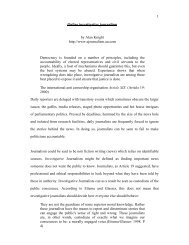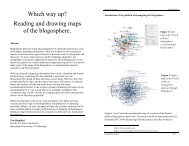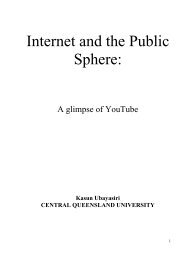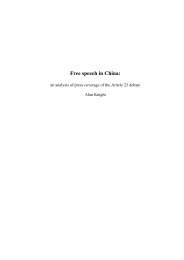Australian mainstream media coverage of Asian football - eJournalist
Australian mainstream media coverage of Asian football - eJournalist
Australian mainstream media coverage of Asian football - eJournalist
Create successful ePaper yourself
Turn your PDF publications into a flip-book with our unique Google optimized e-Paper software.
<strong>Australian</strong> <strong>mainstream</strong> <strong>media</strong> <strong>coverage</strong>… Mike Tuckerman and Leo BowmanPrint journalists Michael Lynch and Marco Monteverde covered thetournament for Fairfax and News Limited respectively, while Sydney-basedjournalist Liam Fitzgibbon provided <strong>coverage</strong> for the <strong>Australian</strong> AssociatedPress (AAP). Scott McIntyre reported nightly for Special BroadcastingService (SBS) news program “The World News” and compiled featurestories for its flagship <strong>football</strong> program “The World Game,” with GerardWhateley providing radio and print <strong>media</strong> <strong>coverage</strong> for the <strong>Australian</strong>Broadcasting Corporation (ABC). I filed feature stories for News Limitedmagazine <strong>Australian</strong> Football Weekly and opinion pieces for sports website“The Roar.” Excluding support staff, broadcast rights holders Fox Sportscontributed four journalists in the form <strong>of</strong> commentators and analysts SimonHill and Andy Harper, producer and website editor Murray Shaw and oncamerareporter Lara Pitt.Fox Sports’ television <strong>coverage</strong> came under the auspices <strong>of</strong> a 2006 broadcastdeal which saw the network pay more than $120 million to broadcast allSocceroos games until 2013 (Football Federation Australia, 2006), excludingthe finals <strong>of</strong> the World Cup. The deal was conceived as a means for FoxSports to broadcast A-League fixtures for a period <strong>of</strong> seven years, but wassigned under the proviso lucrative Socceroos fixtures were included. Thusthe package included the broadcast rights for the 2007 and 2011 <strong>Asian</strong> Cuptournaments, as well as <strong>Asian</strong> Cup and World Cup qualifiers, with the WorldCup finals broadcast on free-to-air network SBS.A survey (Fox Sports, 2011) published by Fox Sports demonstrates theoverall popularity <strong>of</strong> <strong>Asian</strong> <strong>football</strong> <strong>coverage</strong> screened on the network, withthe two highest-rating programs broadcast by Fox Sports in its fifteen yearexistence both fixtures played under the banner <strong>of</strong> the <strong>Asian</strong> FootballConfederation. More than 430,000 viewers tuned into the <strong>Asian</strong>-group WorldCup qualifier between Australia and Uzbekistan at ANZ Stadium in Sydneyin April 2010, while just under 420,000 viewers watched Australia lose in apenalty shoot-out to Japan at the 2007 <strong>Asian</strong> Cup in Vietnam. The next twomost popular broadcasts feature a cricket match and a game in the NationalRugby League, before <strong>football</strong> rounds out the top five with another <strong>Asian</strong>fixture, after more than 375,000 fans tuned into the <strong>Asian</strong>-group World Cupqualifier between Australia and Japan at the Melbourne Cricket Ground inJune 2009.Comparatively, Roy Morgan research figures reveal more than seven million<strong>Australian</strong>s watched Australia beat Japan at the 2006 World Cup inGermany. (Morgan, 2006). The disparity in numbers can be attributed to thelower penetration <strong>of</strong> pay television in <strong>Australian</strong> households, with the 2006World Cup match broadcast exclusively by free-to-air channel SBS (TheEjournalist.com.au 120<strong>Australian</strong> <strong>mainstream</strong> <strong>media</strong> <strong>coverage</strong>… Mike Tuckerman and Leo BowmanAge, 2006). The figures highlight one <strong>of</strong> the most obvious problems for<strong>media</strong> practitioners covering <strong>Asian</strong> <strong>football</strong>: although broadcasting <strong>Asian</strong><strong>football</strong> is increasingly lucrative for television rights holders, the percentage<strong>of</strong> <strong>Australian</strong>s who watch <strong>Asian</strong> <strong>football</strong> differs markedly between pay andfree-to-air TV.Anecdotal evidence suggests fewer <strong>Australian</strong>s are aware <strong>of</strong> <strong>football</strong>’s <strong>Asian</strong>Cup than the World Cup. Returning to John Hoberman’s academic theory <strong>of</strong>“sportive nationalism,” it appears many <strong>of</strong> the seven million <strong>Australian</strong>s whowatched the Socceroos’ clash with Japan in 2006 did so as a means <strong>of</strong> using“sporting success to measure national self-assertion and worth.” In otherwords, millions <strong>of</strong> viewers who tuned in showed little reverence for the game<strong>of</strong> <strong>football</strong> or knowledge <strong>of</strong> Australia or its opponents, but rather saw thematch as an opportunity for the nation to prove itself on the global sportingstage. Furthermore, while viewing figures suggest <strong>Australian</strong>s are aware <strong>of</strong>the global significance <strong>of</strong> the <strong>football</strong> World Cup – in part owing to ourBritish heritage – historical and cultural links between Australia and the<strong>Asian</strong> Cup are virtually non-existent.The practitioner’s perspective“I think it’s fair to say that the move to Asia hasn’t yet caught theimagination <strong>of</strong> the public – in fact, it may never do so – although changingdemographics in Australia could help,” Fox Sports commentator Simon Hilltold me. “In my opinion, the basic problem is that Australia has never seenitself as <strong>Asian</strong> despite the geographic locale – and there are many in Asiawho are <strong>of</strong> a similar view <strong>of</strong> Australia. People in Australia still tend to viewthe world through a European prism and therefore Asia still isn’t really onthe radar in <strong>football</strong> terms, this means fans still tend to have a European teamthey follow first and an <strong>Australian</strong> one as a distant second.”Hill’s assertion that the move to Asia is yet to capture the imagination <strong>of</strong> thepublic is reflected in the fact that one-fifth the number <strong>of</strong> journalists whocovered the World Cup in South Africa travelled to Qatar to report from the<strong>Asian</strong> Cup six months later. “Look at Fairfax, they normally would sendMike (Cockerill) and me, but here I am on my own,” said The Age’s MichaelLynch about working at the <strong>Asian</strong> Cup. Lynch cited cost-cutting as the mainreason Fairfax sent just one reporter to the tournament, after both he andCockerill travelled to Bangkok and Hanoi to cover the 2007 <strong>Asian</strong> Cup.Ejournalist.com.au 121
<strong>Australian</strong> <strong>mainstream</strong> <strong>media</strong> <strong>coverage</strong>… Mike Tuckerman and Leo BowmanLogistical problems also play a role in the lack <strong>of</strong> <strong>Asian</strong> <strong>football</strong> <strong>coverage</strong> inAustralia. Brisbane Times’ managing editor Conal Hanna admitted hiswebsite would feature more prominent <strong>coverage</strong> <strong>of</strong> the AFC ChampionsLeague – a club <strong>football</strong> tournament for Asia’s premier teams – if Australia’s2010-11 A-League champions Brisbane Roar was not forced to wait twelvemonths to take part in it. Australia’s domestic calendar fails to align with theAFC’s, so although more than 50,000 fans turned out at Suncorp Stadium towitness Brisbane Roar win the 2010-11 A-League title in March, <strong>media</strong>momentum is lost in terms <strong>of</strong> covering the Champions League because theRoar must wait a year to take part in the Asia-wide competition.“The <strong>Asian</strong> angle now open to A-League clubs doesn’t register in the publicconsciousness, save for really big games such as Adelaide’s <strong>Asian</strong>Champions League Final versus Gamba Osaka and Australia’s World Cupqualifiers,” said Simon Hill. “Even the recent <strong>Asian</strong> Cup, where Australiareached the final, didn’t grab people. In fact, I remember reading onecomment online which said, ‘I won’t be interested until Australia wins theEuropean Championship’ – which, however laughable that statement is, justabout sums up how people view Asia and this country.”Keeping <strong>Asian</strong> voices out <strong>of</strong> the <strong>media</strong>Reporting from the <strong>Asian</strong> Cup, The Courier Mail’s <strong>football</strong> reporter MarcoMonteverde admitted there was little enthusiasm for the tournament from thegeneral public. “<strong>Australian</strong>s just don’t care,” was Monteverde’s succinctsummation, although he worked tirelessly to file daily reports.Monteverde’s match report from Australia’s 1-1 group-stage draw withKorea Republic highlights how agenda setting can hinder the public’sknowledge <strong>of</strong> <strong>Asian</strong> <strong>football</strong>ers (Monteverde, 2011). Eager to obtain quotesfrom the South Korean players, Monteverde and I spoke to midfielder KiSung-Yueng who spent five years at Brisbane school John Paul Collegebefore returning to his native country. Ki admitted to Monteverde and I thathis side altered their tactics to counter the physically imposing Socceroos,but despite this newsworthy admission, Monteverde’s match report made nomention <strong>of</strong> the midfielder’s frank assessment, with the journalist latersuggesting most <strong>Australian</strong> fans “don’t have a clue who Ki is.”A similarly popular <strong>media</strong> target before and after the clash with South Koreawas Socceroos defender Sasa Ognenovski. Born in Melbourne, the centraldefender played with A-League clubs Brisbane Roar and Adelaide UnitedEjournalist.com.au 122<strong>Australian</strong> <strong>mainstream</strong> <strong>media</strong> <strong>coverage</strong>… Mike Tuckerman and Leo Bowmanbefore joining South Korean side Seongnam Ilhwa in 2009. A well respectedplayer at the K-League club, Ognenovski was soon appointed captain andlead the South Korean side to the AFC Champions League title in 2010. Hisknowledge <strong>of</strong> <strong>Asian</strong> <strong>football</strong> made him an obvious interview candidate,however the normally affable Ognenovski originally refused to speak toMonteverde, blaming The Courier Mail journalist for a rift between him andformer Brisbane Roar coach Frank Farina. Only a hasty apology fromMonteverde resolved the situation, highlighting just how difficult it can be toprovide balanced journalism in an environment in which personality clashes<strong>of</strong>ten hinder the ability to obtain information and quotes.Playing globally, reporting locallyOn the topic <strong>of</strong> why <strong>Asian</strong> <strong>football</strong> struggles to gain more <strong>mainstream</strong> <strong>media</strong>exposure, Simon Hill argues the traditional <strong>Australian</strong> sports <strong>media</strong> is stilldominated by an “old-world” mentality. “The vastness <strong>of</strong> Australia and lack<strong>of</strong> transport options lead to the development <strong>of</strong> sporting competitions thatwere, historically, inter-district tournaments – anything else was too faraway, too remote. That parochial mindset exists even today, despite cheap airtravel and the internet, and in a way it’s understandable – the clubs have builthuge rivalries down the years, while the players live locally and arerecognisable faces,” Hill said. “As a consequence, newspaper editors andtelevision executives reflect this, and pay little regard to <strong>football</strong> in general –a national competition with few local rivalries – and <strong>Asian</strong> <strong>football</strong>. Many<strong>Asian</strong>-literate <strong>football</strong> fans in Australia blame the bigwigs for this – but it’smy experience that sadly they are only reflecting the public’s generaldisinterest. Newspapers, TV and radio exist to make money and executivesand editors aren’t stupid. They only give the public what they think theywant,” he said.Hill’s bleak assessment isn’t quite matched by SBS reporter Scott McIntyre,who highlights changing <strong>media</strong> attitudes towards <strong>football</strong> since the advent <strong>of</strong>the A-League. “For those very few <strong>of</strong> us in the <strong>Australian</strong> <strong>media</strong> who havebeen reporting on <strong>Asian</strong> <strong>football</strong> there is a clearly defined shift post-2005,”McIntyre told me. “It is truly hard to believe the amount <strong>of</strong> <strong>coverage</strong> herenow compared to the time prior to the AFC switch. On one level it’scomforting to know that <strong>Australian</strong> <strong>football</strong> fans, clubs and sponsors arefinally engaging with the region but there is still a lot to be done.”Like Hill, former Tokyo resident McIntyre believes the influence <strong>of</strong> domesticcodes plays a major role in how <strong>football</strong> is covered. “The other major sportsEjournalist.com.au 123
<strong>Australian</strong> <strong>mainstream</strong> <strong>media</strong> <strong>coverage</strong>… Mike Tuckerman and Leo Bowmanin Australia are primarily domestic codes whose reach and outlook isn’tinternational. In both cases they organise the premier domestic sportingcodes here in Australia and as such have little or no interest in looking at theregional or indeed global outlook for their sports,” McIntyre said. He arguesa lack <strong>of</strong> journalists familiar with <strong>Asian</strong> <strong>football</strong> and the region is one <strong>of</strong> thereasons <strong>Australian</strong> sports fans remain largely unaware <strong>of</strong> the <strong>football</strong> beingplayed on their doorstep. “One <strong>of</strong> the key changes needed in the future is tokeep engaging <strong>media</strong> analysts who are familiar with the region – those whohave played or lived and worked closely with the game in the region –particularly those with language skills who can report first-hand rather thanrelying on second-hand reports or those who spend significant time on theground,” McIntyre said. “As we’ve seen though with Robbie Slater on FoxSports News pronouncing Kashima as ‘Cashmere’ three times, or The DailyTelegraph here refering to FC Tokyo as both Tokyo FC and Tokyo United,there’s still a lot to learn about engagement at a real level.”From goalkeepers to gate-keepersLocal biases and language barriers may play a role in keeping <strong>Asian</strong> <strong>football</strong>stories out <strong>of</strong> the <strong>Australian</strong> <strong>media</strong>, however casual indifference is anotherpowerful obstacle. Although Socceroos striker Josh Kennedy finished equaltop scorer in Japan’s J. League in 2010 – widely regarded as Asia’s premierdomestic league – his withdrawal through injury from the 2011 <strong>Asian</strong> Cupreceived substantially less on-going <strong>media</strong> <strong>coverage</strong> than the overall fitness<strong>of</strong> <strong>Australian</strong> team-mate Tim Cahill, who plays his club <strong>football</strong> for EnglishPremier League side Everton. Similarly, Socceroos defender Jon McKainwent through an <strong>Asian</strong> Cup played in the unfamiliar surrounds <strong>of</strong> Qatarunquestioned by journalists, despite playing his club <strong>football</strong> across theborder with Saudi club Al-Nassr.The popularity <strong>of</strong> English <strong>football</strong> in Australia and this country’s longstandingcultural links with Britain has another potentially pernicious effecton <strong>media</strong> <strong>coverage</strong> <strong>of</strong> the <strong>Asian</strong> game, with most influential positions withinthe <strong>Australian</strong> <strong>football</strong> <strong>media</strong> held by English-born journalists.TV ratingssuggest the English Premier League remains widely popular with <strong>Australian</strong>sports fans, (Astra, 2009) yet the impact <strong>of</strong> English editors on <strong>Australian</strong><strong>football</strong> <strong>coverage</strong> is yet to be explored. Even when links between Englandand <strong>Asian</strong> <strong>football</strong> are tenuous, <strong>Australian</strong> <strong>media</strong> outlets traditionally defer toEnglish-born journalists.<strong>Australian</strong> <strong>mainstream</strong> <strong>media</strong> <strong>coverage</strong>… Mike Tuckerman and Leo BowmanConclusionReflecting on my time in Qatar and on the sports desk at Brisbane Times, Iposited the question; to what extent does agenda setting, in line with theparticular structures <strong>of</strong> the <strong>Australian</strong> sports field, provide a form <strong>of</strong>reportage that might limit the broader consciousness <strong>of</strong> sports followers <strong>of</strong>the changing face <strong>of</strong> their favourite game? Focusing specifically on how thatquestion relates to the <strong>coverage</strong> <strong>of</strong> <strong>Asian</strong> <strong>football</strong>, I concluded that a number<strong>of</strong> factors play a role in limiting the scope <strong>of</strong> <strong>Asian</strong> <strong>football</strong> <strong>coverage</strong> inAustralia, and thereby contribute to the lack <strong>of</strong> fan engagement with the<strong>Asian</strong> game. Agenda setting by <strong>media</strong> outlets is prominent, with printpublications and television <strong>coverage</strong> favouring sports stories with a localangle over those from an international perspective. Where publications andTV <strong>media</strong> are open to the prospect <strong>of</strong> increasing <strong>Asian</strong> <strong>football</strong> <strong>coverage</strong>,indications suggest a lack <strong>of</strong> cultural and historical ties to Asia leaves fanslargely disinterested in <strong>Asian</strong> <strong>football</strong>.Despite the increasingly globalised nature <strong>of</strong> <strong>media</strong>, pr<strong>of</strong>essional sportsteams remain deeply entrenched members <strong>of</strong> local communities, and thisunique cultural economy inhibits broader <strong>media</strong> <strong>coverage</strong> <strong>of</strong> teams involvedin both local and international competitions. With sports reporters beholdento editorial policies which emphasise a close local relationship, journalistsare afforded little scope to expand their analyses beyond match reports andcontent featuring heavy focus on readily identifiable players. The strictcontrol imposed on player access also has a role in limiting <strong>coverage</strong> andclubs are increasingly wary <strong>of</strong> exposing their players to the <strong>media</strong>. Thismeans sports reporting can lack colour and depth, with terse match reportspredominant and a cadre <strong>of</strong> favoured players <strong>of</strong>ten relied upon for quotes.Language barriers further complicate reporting between <strong>Australian</strong>journalists and <strong>Asian</strong> sides and not surprisingly, English-speaking <strong>Asian</strong>players are almost exclusively sort out for interviews at major tournamentssuch as the <strong>Asian</strong> Cup, thereby limiting the diversity <strong>of</strong> voices heard.Australia’s close cultural ties to Britain and the popularity <strong>of</strong> the EnglishPremier League with <strong>football</strong> fans make it difficult to expand <strong>coverage</strong> <strong>of</strong> the<strong>Asian</strong> game. With <strong>football</strong> already a minority sport in terms <strong>of</strong> <strong>media</strong><strong>coverage</strong> in Australia, the A-League and English <strong>football</strong> dominate newsstories, pushing <strong>coverage</strong> <strong>of</strong> <strong>Asian</strong> <strong>football</strong> to the fringe. That may changeover time, however <strong>coverage</strong> <strong>of</strong> <strong>Asian</strong> <strong>football</strong> has not increasedexponentially with the initial surge <strong>of</strong> interest the switch to the <strong>Asian</strong>Football Confederation generated in 2005.Ejournalist.com.au 124Ejournalist.com.au 125
<strong>Australian</strong> <strong>mainstream</strong> <strong>media</strong> <strong>coverage</strong>… Mike Tuckerman and Leo BowmanThe general indifference with which many <strong>Australian</strong> journalists approach<strong>Asian</strong> <strong>football</strong> is another hindrance. Several <strong>football</strong> journalists ignored myrequests for information, whilst a number <strong>of</strong> <strong>football</strong> publications did notsend a reporter to the <strong>Asian</strong> Cup. The general under-reporting <strong>of</strong> players at<strong>Asian</strong> clubs is mirrored by an unwillingness to liaise with <strong>Asian</strong> <strong>media</strong>personnel, reflecting an insular and inward-looking sports <strong>media</strong> focusedlargely on producing local and domestic content.With Australia set to host the 2015 <strong>Asian</strong> Cup, <strong>media</strong> <strong>coverage</strong> <strong>of</strong> <strong>Asian</strong><strong>football</strong> may increase as the tournament draws near. However, as myresearch has indicated, the question <strong>of</strong> why <strong>Asian</strong> <strong>football</strong> receivescomparably little <strong>media</strong> <strong>coverage</strong> in relation to other sports produces a multifacetedresponse. Expected to work within the contraints <strong>of</strong> a sportsjournalism system which values timeliness over thoroughness, is <strong>of</strong>tenparochial and which is heavily skewed towards local-interest stories, sportsreporting outside <strong>of</strong> this framework is difficult. Moreover, while a newgeneration <strong>of</strong> <strong>Asian</strong>-savvy sports journalists may ultimately produce more indepthanalyses <strong>of</strong> <strong>Asian</strong> <strong>football</strong> and how it relates to the <strong>Australian</strong> game,my research suggests <strong>media</strong> <strong>coverage</strong> <strong>of</strong> <strong>Asian</strong> <strong>football</strong> in Australia iscommensurate with current public interest.If the interaction between sports journalists and their sources is largelyresponsible for shaping public consciousness <strong>of</strong> <strong>Asian</strong> <strong>football</strong>, a change <strong>of</strong>practices in the field <strong>of</strong> sports reporting may be required for sports journaliststo broaden their knowledge <strong>of</strong> <strong>Asian</strong> <strong>football</strong> and thus provide more balancedand informed <strong>coverage</strong> <strong>of</strong> the <strong>Asian</strong> game.The change will require the cooperation <strong>of</strong> both journalists and editors, for itis the latter who possess the editorial authority to re-shape the sportsjournalism field into a model more closely associated with other journalisticrounds. Sports <strong>media</strong> departments will also play a role, particularly whereinteraction between <strong>Asian</strong> clubs and <strong>Australian</strong> journalists is concerned,while the provision <strong>of</strong> access to sources remains critical. Lastly, audienceengagement and pr<strong>of</strong>itability are also key. While agenda setting plays anobvious role in impeding <strong>Australian</strong>s’ knowledge <strong>of</strong> <strong>Asian</strong> <strong>football</strong>, so toodoes fan disinterest contribute to the lack <strong>of</strong> tangible economic benefits for<strong>media</strong> outlets providing <strong>coverage</strong> <strong>of</strong> the <strong>Asian</strong> game. Thus a cycle occurswhereby <strong>media</strong> outlets are reluctant to cover <strong>Asian</strong> <strong>football</strong> for an audiencedisinterested in receiving it, reflecting the current trend <strong>of</strong> <strong>Asian</strong> <strong>football</strong>receiving comparatively little <strong>coverage</strong> in the <strong>Australian</strong> <strong>media</strong> in relation toother sports.<strong>Australian</strong> <strong>mainstream</strong> <strong>media</strong> <strong>coverage</strong>… Mike Tuckerman and Leo BowmanBibliographyBourdieu, Pierre. ‘How Can One Be A Sports Fan?’ in During, Simon (ed.),The Cultural Studies Reader, Routledge Press, London, 1993Boyle, Raymond. Sports Journalism: Context and Issues, Sage Publications,LondonCashman, Richard. Paradise Of Sport: A History <strong>of</strong> <strong>Australian</strong> Sport, WallaWalla Press, Sydney, 1995Cashman, Richard. Sport In The National Imagination: <strong>Australian</strong> Sport inthe Federation Decades, Walla Walla Press, Sydney, 2002Chibnall, Steve. Law and order news: An analysis <strong>of</strong> crime reporting in theBritish press, Cambridge University Press, Cambridge, 1977Cohen, Bernard. The press and foreign policy, Princeton University Press,Princeton, 1993Duerden, John. “<strong>Asian</strong> <strong>football</strong> – it’s not about the money,” Ninemsn,January 28, 2011Fink, Jesse. 15 Days In June: How Australia Became A Football Nation,Hardie Grant Books – (Second edition), Melbourne, 2007Foster, Craig. Fozz On Football, Hardie Grant Books, Melbourne, 2010Gray, David. Doing Research In The Real World, (Second edition), SagePublications, London, 2009Habermas, Jürgen The Structural Transformation <strong>of</strong> The Public Sphere: AnEnquiry into a Category <strong>of</strong> Bourgeois Society, Polity Press, CambridgeJorgensen, Danny. Participant Observation: A Methodology for HumanStudies, Sage Publications, Newbury ParkMonteverde, Marco. “Socceroos salvage 1-1 draw against South Korea in<strong>Asian</strong> Cup,” The Courier Mail, January 15, 2011Morgan, Gary. “<strong>Australian</strong>s Stay Up Late For Socceroos,” Roy MorganResearch, June 16, 2006Ejournalist.com.au 126Ejournalist.com.au 127
<strong>Australian</strong> <strong>mainstream</strong> <strong>media</strong> <strong>coverage</strong>… Mike Tuckerman and Leo BowmanRowe, David. ‘Fourth estate or fan club? Sports journalism engages thepopular,’ in S Allen (ed.), Journalism: critical issues, Open University Press,London, 2005Shenon, Philip. “Malaysia Premier Demands Apology,” New York Times,December 9, 1993Smithies, Tom.“Josh Kennedy injury sours <strong>Asian</strong> Cup campaign,” The DailyTelegraph, December 22, 2010Thompson, Trevor. One Fantastic Goal: A complete history <strong>of</strong> <strong>football</strong> inAustralia, ABC Books, 2006“Brosque allowed to leave Sydney FC,” <strong>Australian</strong> BroadcastingCorporation, January 31, 2011“English Premier League season starts on Subscription TV,” Astra, August17, 2009“Historic deal to secure Football’s future,” Football Federation Australia,May 3, 2006“New Town vs Cricketers,” The Mercury, June 9, 1879“SBS gets 2010 and 2014 World Cup rights,” The Age,, March 18, 2006“We bring you a list <strong>of</strong> the 15 most-watched matches ever broadcast on FoxSports,” Fox Sports, April 5, 2011Ejournalist.com.au 128








